The Venomous Beauty of ‘By the Sea’ by Angelica Jade Bastién
By Yasmina Tawil
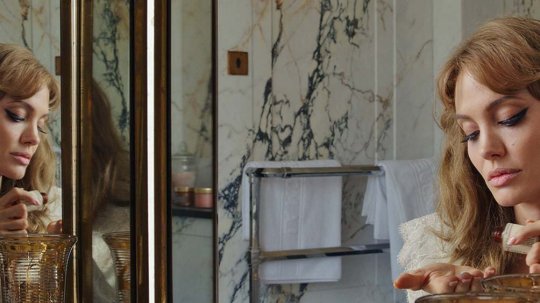
[This month, Musings pays homage to Produced and Abandoned: The Best Films You’ve Never Seen, a review anthology from the National Society of Film Critics that championed studio orphans from the ‘70s and ‘80s. In the days before the Internet, young cinephiles like myself relied on reference books and anthologies to lead us to film we might not have discovered otherwise. Released in 1990, Produced and Abandoned was a foundational piece of work, introducing me to such wonders as Cutter’s Way, Lost in America, High Tide, Choose Me, Housekeeping, and Fat City. (You can find the full list of entries here.) Over the next four weeks, Musings will offer its own selection of tarnished gems, in the hope they’ll get a second look. Or, more likely, a first. —Scott Tobias, editor.]
As a woman you learn early and often how beauty is its own currency and how easily it can be turned against you.
Every generation has had otherworldly figures that communicate this truth writ large— Lana Turner, Joan Crawford, Elizabeth Taylor, and, of course, Angelina Jolie. In previous generations, actresses learned to make a meal out of the male gaze and its relationship to the contradictory power women can find in using their own beauty as a weapon. This gave us indelible moments like Rita Hayworth’s striptease in Gilda, Michelle Pfeiffer slinking across the screen in latex as Catwoman in Batman Returns, and pretty much anytime 1950s sex bomb Marilyn Monroe had a camera in front of her. In Sunset Boulevard, when Norma Desmond looks at her past self on-screen with a mix of nostalgia and anger, she isn’t just mourning the past of the industry that made her famous, but the power that came with the brand of womanhood she exhibited in her youth. In her third feature as writer-director, By the Sea, Angelina Jolie takes the rarely seen approach of interrogating the art of watching and being watched as a woman through a prickly, even combative female gaze.
At first glance, By the Sea has a simple, even thin plot, with not much to offer. In 1970s Malta, an American couple take a trip to a coastal hotel in hopes of fixing their rotting marriage. Vanessa (Jolie) is a former dancer in a perpetual opiate haze, numbing herself to a past tragedy, while Roland (Brad Pitt) is a formerly successful writer pickling himself with whatever booze is around. Things take a perverse turn when Vanessa discovers a peephole that lets her look into the room of the young, hot, newlyweds next door, Léa (Mélanie Laurent) and Francois (Melvil Poupaud). For a good portion of the film characters seem remarkably passive — they drink, fuck, or lie dazed on balconies.
Upon closer examination, By the Sea proves to be a beguiling mix of existential erotic thriller and tone poem—an audacious, challenging film brimming with heady ideas. With profound emotion and visual ingenuity, the film examines how love so often curdles into hate, the art of seeing and being seen, and meta-textually, the currency of movie stars in a cinematic landscape starved of them.
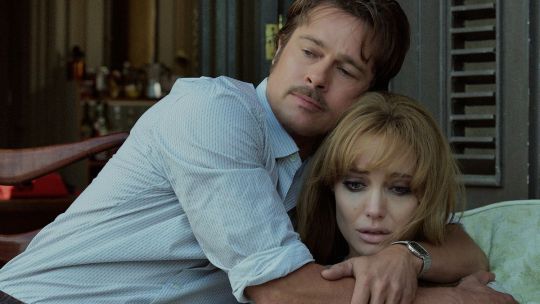
It’s clear from the first few minutes that Jolie is a startlingly self-aware artist. She understands how her presence and that of her equally famous soon-to-be-ex husband can warp a film—and she takes full advantage. By the Sea has the sort of grand, movie star introduction we don’t see all that often; it leans into Jolie and Pitt’s outsized personas rather than obscures them. In a dashing silver convertible, they drive the winding Mediterranean roads, passing by rocky mountains and the cerulean sea. They sit wordlessly next to each other. He has a surface level affability and looseness to his demeanor. She’s unmoving, inscrutable. Yes, it’s gorgeously shot and utterly alluring. But there is an uneasiness to their silence that hints at the turmoil to come.
Thanks to its slow rhythm and repetitiveness, By the Sea weaves a strange spell. As images of the older fisherman rowing through the sea, Roland drinking himself into an embarrassing stupor, and Vanessa artfully arranging herself across the room continue, the film lulls us into a place of comfort. Jolie isn’t interested in the typical conventions of plot or even what’s to be expected of artful projects celebrities create for themselves. She instead shows a finely tuned interest in mood. Once Vanessa discovers the peephole and the illicit thrill of stepping into the lives of the idyllic newlyweds, she can’t turn back. There’s a raw brutality to the way Roland and Vanessa interact with each other that amp up after she discovers the peephole. They’re like two wounded animals clawing at each other. But what is entirely unexpected are the flashes of cruel humor and absurdity.
When she hears Roland coming back to the room one day, she plugs up the peephole and slides across the floor with a frantic sloppiness. She casts one of her blank stares, playing coy. But he already found the peephole on his own. It’s a brief moment but it’s utterly ridiculous to watch—her fear of being discovered, his knowing glance, her feigning the sort of opiate stupor he’s come to expect. Then the whole film takes a turn. “Will you watch with me?,” Roland asks. Soon Roland and Vanessa are making their voyeurism into a daily ritual.
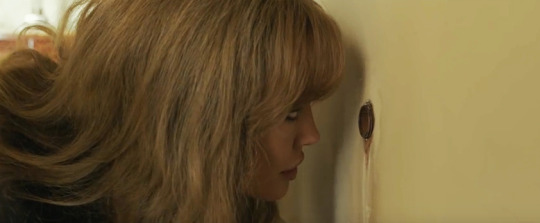
But Vanessa isn’t satisfied with just watching them. She wants to influence them. Roland goes along with it out of the misguided hope of bringing back Vanessa from the edge. He sees the libidinal thrill she gets from watching this couple and watching Roland watch them as well. Even though she’s dedicated to staying in the hotel and not venturing any further than the market, he sees their voyeurism as an opportunity to give their marriage the spark that was seemingly extinguished years prior. He even goes so far as to suggest they get the neighboring couple drunk and watch what happens later.
What follows is a brief, kinetic scene of them getting ready in the bathroom. The camera swoons around Vanessa as she sprays her bouffant with copious hairspray. Just to her side, Roland waves a towel with one hand and drinks with the other. Their understanding of one another is clear in how they move: Her at the vanity, him at the sink. Him with his liquor, her with the pills.
By the Sea understands marriage and the way people who’ve been together for a long time can hurt each other. This is most pointed in the film’s relationship with intimacy. Over dinner with the objects of their voyeurism, the noise of the café fades away as if Vanessa’s hearing everything through another hole in the wall, rather than actually being present. Characters often look directly at the camera (or just about) as if in conversation with the audience. Important meetings (like the first time Vanessa comes upon Léa in real life rather than through watching her) are shot from a distance—whole conversations unheard in favor of taking the perspective of another character watching from afar. Mirrors are a pivotal device for Jolie as a director. Roland and Vanessa often exchange meaningful glances not by looking directly at each other, but at their reflections. Late in the film, Roland forces Vanessa to go out for dinner and dancing. She’s nervous, her voice barely above a ragged whisper. He lovingly smiles, trying to get her out of her shell. When he takes her onto the dance floor, things start out romantically. But soon she begins spinning like a broken top. She flails and sidesteps and twirls. In the fragmented mirror above the dance floor, her reflection is splintered into several duplicates as she continues to move with manic energy before Roland comes to her side.
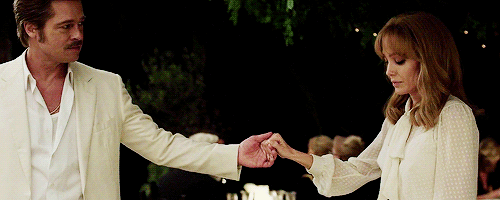
By the Sea’s cunning understanding of the ways being seen affects identity extends beyond Christian Berger’s lush cinematography, with its painfully intimate framing and rich color palette. The costuming by Ellen Mirojnick gives the film a timeless quality and strengthens the characterization. Good costuming is beautiful. But great costuming is lived in, acting as architecture for the actors. It not only frames their face but brings the internal machinations of their characters into the physical realm in subtle ways. Vanessa is entirely devoid of color, her hair an ashen blonde that hews a little too close to Jolie’s skin. She only wears snowy whites, fresh creams, and deep blacks. But as her obsession continues, pops of color are introduced—pink lipstick, the blue pills she knocks back, and a skirt red like a fresh wound when they go sailing. In one of the most harrowing scenes near the end, Roland peers through the peephole to find Vanessa with Francois; when he undoes her top, her bra underneath is a striking red. Mirojnick’s costumes go so far as to suggest that Vanessa “self-medicates” with luxury. After an incident that alludes to a failed suicide attempt, she returns to the hotel drenched in ocean water, looking like a shipwrecked bride. Even in her despair, she’s gorgeous.
Throughout the film, there are hints as to what cataclysmic tragedy upended their marriage. Vanessa’s long gazes at children are an early tell. After Roland discovers Vanessa’s flirtation with adultery, he drags her back into their room, forcing her to acknowledge the emotions that are keenly felt but left unexplained. She’s barren. In watching Léa, she didn’t only want to witness someone else’s fairytale early marriage (and remember her own) but utterly destroy it. Watching Léa reminds her of her inability to have children after several failed pregnancies.
In watching Vanessa glamorously sulk around the hotel room, committing one self-destructive act after another, I thought of something Truman Capote wrote describing the common thread between Elizabeth Taylor, Judy Garland, and Marilyn Monroe. “[They had an] emotional extremism, a dangerously greater need to be loved than to love, the hotheaded willingness of an incompetent gambler to throw good money after bad.” It’s easy to turn unlikeable, grotesque, outsized women into camp spectacles. But Jolie avoids that trap while still finding humor in this hard-to-love story. Even as Vanessa harms everyone around her, especially Roland, with increasing cruelty you can’t help but understand, even sympathize with her, since Jolie so fully constructs this broken doll of a woman. You understand the anguish beneath her manicured surface, even as she reveals herself to be as wounding as she is wounded.
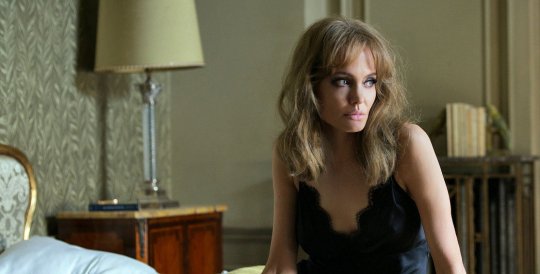
By the Sea shows the influence of Bergman, Antonioni, and Godard in its moodiness, pacing, and styling. Critic Kim Morgan, one of the few defenders of the film, also sees a bit of Roman Polanski’s Bitter Moon. But it feels more profoundly like the spiritual heir to the collaborations between another legendary couple, Elizabeth Taylor and Richard Burton. The venomous wit of Who’s Afraid of Virginia Woolf? and the cracked out Boom! are its clearest antecedents. There’s enough haunting melancholy and elegant vulgarity to make By the Sea escape being mere mimicry. Jolie understands “primal pull” that classic Hollywood movie stars represent. Watching Ava Gardner with haughty grace smoke cigarettes in The Killers or an impeccably styled Bette Davis walk off the ship in Now, Voyager holds an allure that’s hard to explain and even harder to deny. Jolie leans into this seductive power, displaying it over and over again until it’s nearly unbearable. This highlights the greatest strength of the film: how it argues acting is its own form of auteurism.
As Vanessa, Jolie gives a towering performance, communicating the ways women buckle under interpersonal expectation. Her elegant physicality nods to the character’s past as a professional dancer—she’s always in various states of elegant repose. Even when she’s a makeup-smeared, hysterical mess, there’s a sense that she’s still posing and adjusting herself, as if being watched and studied. She’s either in a drug riddled haze, a violent hysteric, or wearing a mask with no legible emotion. She’s a woman of extremes. Jolie asks in every line reading and every gesture for us to understand Vanessa’s disinterest in being likable.
Watching the vicious critical appraisal of the film when it was released two years ago, I couldn’t help but think of what John Berger wrote in The Ways of Seeing, “You painted a naked woman because you enjoyed looking at her, put a mirror in her hand and you called the painting ‘Vanity,’ thus morally condemning the woman whose nakedness you had depicted for you own pleasure.” It wasn’t so much that the film was hated but that many critics refused to engage with the film itself. Instead of seeing the outsized personalities of the star couple at its center as something that enriches the way the film approaches voyeurism and the personalities we craft for people, it was seen as a hinderance. There was a sexist edge in the oft-heard critique of the film as a “vanity project” as well. As Sheila O’Malley wonderfully states in her appraisal of the film, “In order for that criticism to be valid, Angelina Jolie would have cast herself as the luscious sexually-alive object-of-desire living next door, seen through the hole in the wall. But Jolie didn’t do that. Instead, she plays a woman jealous of that golden happy sexy woman next door.” The criticism of By the Sea was virulent and intellectually simplistic in ways that showed disinterest in how women construct themselves, as if their dreams and fantasies can’t have value. It’s this sort of mindset that adds to why women struggle to find footing in Hollywood in meaningful ways as directors. It also displays a discomfort for when a woman of great beauty turns herself into the subject rather than an object.
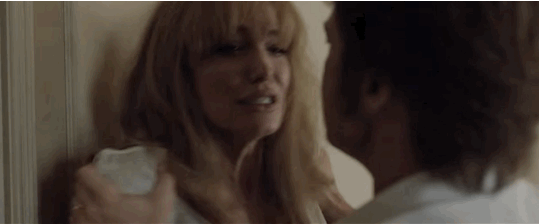
An actress of Jolie’s stature is the architect of her own image and story in ways that American culture still scorns. Yes, there is a meta-textual edge to By the Sea, given its topics of child loss, adultery, the art of being watched, and beautiful people making a mess of things. But By the Sea amounts to more than merely being a gorgeous, meta take on one of Hollywood’s most famous couples.
With By the Sea, Jolie encapsulates the cardinal sin women are warned against: she doesn’t give a damn if you like her. She eschews plot for mood, easy answers for hard truths. She privileges beauty as not only an important pleasure to be found in cinema but a subject worthy of intellectual study. In doing so, she creates nothing short of a masterpiece.

